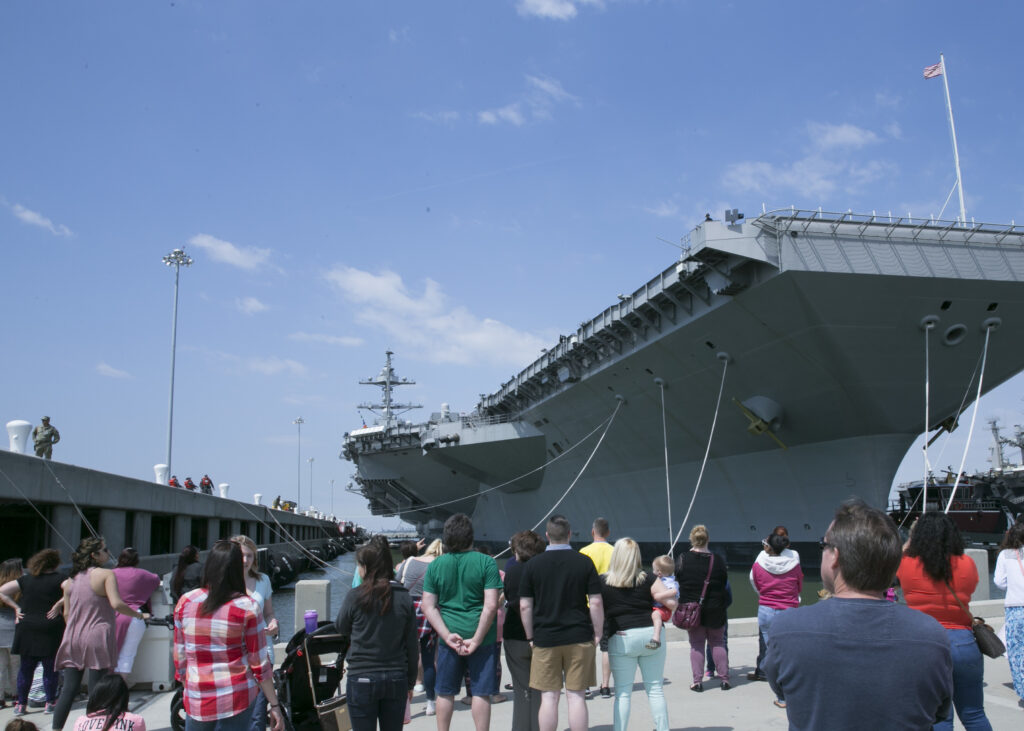
ARLINGTON, Virginia ꟷ Shipbuilding giant HII had higher than usual growth through the third quarter of fiscal 2023, but a potential delay in contracting for two new aircraft carriers could lead to supply chain disruptions, the company CEO said in a media briefing on Jan. 8 in advance of the Surface Navy Association symposium this week.
“The company’s actually doing pretty great,” said CEO Christopher D. Kastner, who took over the company reins in March 2022. HII racked up 5% growth through Q3 of fiscal 2023, higher than its historical average of 3%.
“We’ve had a very solid 2023, we’ve grown at about 5% year-over-year through Q3, raised guidance on our top line for sales and free cash flow on our Q3 earnings call, so … we’re kind of at an inflection point from a growth standpoint,” he said.
Kastner said some company priorities appear to be supported in the pending fiscal 2024 defense authorization, including the LPD 33 amphibious warship. “Keeping the amphib line is very important to Ingalls” shipbuilding, Kastner said.
The company’s two shipyards have 41 ships in production and its Mission Technologies division, which builds and develops unmanned systems, AI systems and others, had more than $5 billion in awards during the year, including a $350 million contract for small unmanned underwater vehicles.
Seventeen submarines will go under contract in the next year to 18 months, and progress is being made on the AUKUS program to provide Australia with nuclear-powered submarines.
“We expect revenue to flow in 2024,” Kastner said. “We don’t believe it will be financially material in ’24, but there could be revenue flowing in ’24.”
Carrier Schedule
One potential fly in the ointment is the possibility of the next two-ship aircraft carrier buy being shifted by a year or two, from 2028 to 2029 or even 2030. In 2019, the Navy contracted for two carriers, CVN 80 and 81, the future Enterprise and Doris Miller.
“I think there’s a broad understanding that the supply chain is a material risk to achieving the production schedules on future Navy programs. And our job as shipbuilders is to manage risk,” Kastner said. “If we can eliminate one of those risks, or significantly reduce one of those risks by getting advanced procurement in place, well ahead of the ship being ordered, it only makes sense to do it. We know the ships are going to be built, they have broad support, so let’s eliminate risk, let’s get the major suppliers under contract early enough so they can plan and they can make their production schedules.”
A Newport News Shipbuilding executive, who asked not to be named, said the company is promoting a 2-3-4 concept for USS Gerald Ford-class aircraft carriers to create a “stable, predictable and consistent cadence within our industrial base.” That means a two-ship buy; at least three years of advanced procurement funding; and four-year build intervals between ships. “I believe the 2-3-4 strategy needs to be codified as the standard moving forward,” he said.
A delay in the procurement of CVN 82 is “extremely disappointing,” and could break the momentum of a rebuilding carrier production line “and have a detrimental impact on the entire nuclear shipbuilding industry, including submarine construction,” he said.






